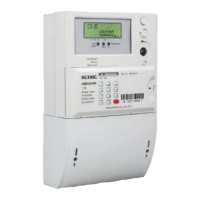
Do you have a question about the HEXING HXE310-KP and is the answer not in the manual?
| Product Type | Smart Meter |
|---|---|
| Phase | Single Phase |
| Current | 5(60)A |
| Accuracy Class | Class 1 |
| Standard | IEC 62052-11, IEC 62053-21 |
| Frequency | 50Hz |
| Display | LCD |
| Operating Temperature | -25°C to +60°C |
| Storage Temperature | -40°C to +70°C |
| Protection Class | IP54 |
| Measurement Type | Active Energy |
| Communication | RS485, Infrared |
Lists the IEC standards the meter complies with.
Explains the six core functional parts of the meter.
Details the meter's electrical and environmental specifications.
Describes the physical layout and external components.
Covers energy measurement, instantaneous values, and billing.
Details the optical communication port and its standards.
Covers physical features, icons, and display modes of the LCD.
Illustrates the various icons displayed on the LCD screen.
Maps LCD segments and symbols to their meanings.
Explains different LCD display modes like auto-scrolling.
Details status indications like cover open and overload events.
Lists display items, OBIS codes, and data formats.
Explains recharging, management, and test tokens using STS.
Details the process of entering a 20-digit token for credit recharge.
Covers setting maximum power and clearing credit balance via tokens.
Details tokens for full, relay, and LCD testing procedures.
Explains canceling meter registration using specific tokens.
Lists short codes for quick retrieval of meter information.
Covers credit status visual and audible alarms.
Describes LED indicators for low credit status.
Explains the audible alarm and how to cancel it.
Details the emergency overdraft function and its usage.
Explains how the meter controls load based on power limits.
Covers recording occurrence time and related information for events.
Lists event types like power off, cover open, and voltage issues.
Records event times, duration, and occurrence/ending details.
Includes standard, tampering, relay, and grid events with event IDs.
Details physical features and priority levels of the internal relay.
Describes the relay's magnetic latching and operational limits.
Lists operation codes and priority levels for relay control.
Explains how the meter checks and maintains relay status.
Defines what constitutes a relay malfunction.
Covers the meter's clock module, accuracy, and calibration.
Details the fitted Lithium battery and its role when power is off.
Explains switching from installation mode to normal operation.
Describes the fault alarm LED and its configurable events.
Provides the meter's length, width, and height dimensions.
Details the layout and numbering of the terminal block.
Illustrates the wiring connections for the meter.
Provides guidelines for correct meter installation and location.